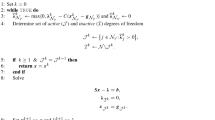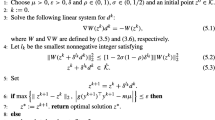Abstract
We solve the non-linearized and linearized obstacle problems efficiently using a primal-dual hybrid gradients method involving projection and/or \(L^1\) penalty. Since this method requires no matrix inversions or explicit identification of the contact set, we find that this method, on a variety of test problems, achieves the precision of previous methods with a speed up of 1–2 orders of magnitude. The derivation of this method is disciplined, relying on a saddle point formulation of the convex problem, and can be adapted to a wide range of other constrained convex optimization problems.





Similar content being viewed by others
Notes
Code available at http://www.math.montana.edu/dzosso/code.
None of these sources explicitly specifies the boundary values other than claiming \(f=0\) on “some” (undisclosed) location, clearly different from the square border \(\partial \varOmega \).
References
Arrow, K.J., Hurwicz, L., Uzawa, H.: Studies in Linear and Non-Linear Programming. Cambridge Univ Press, Cambridge (1958)
Attouch, H., Buttazzo, G., Michaille, G. (eds.): Variational Analysis in Sobolev and BV Spaces: Applications to PDEs and Optimization, 2nd edn. SIAM, Philadelphia, PA (2014)
Beck, A., Teboulle, M.: Fast gradient-based algorithms for constrained total variation image denoising and deblurring problems. IEEE Trans. Image Process. 18(11), 2419–2434 (2009). doi:10.1109/TIP.2009.2028250
Bhaya, A., Kaszkurewicz, E.: Steepest descent with momentum for quadratic functions is a version of the conjugate gradient method. Neural Netw. Off. J. Int. Neural Netw. Soc. 17(1), 65–71 (2004). doi:10.1016/S0893-6080(03)00170-9
Braess, D., Carstensen, C., Hoppe, R.H.W.: Convergence analysis of a conforming adaptive finite element method for an obstacle problem. Numer. Math. 107(3), 455–471 (2007). doi:10.1007/s00211-007-0098-6
Brezis, H., Sibony, M.: Méthodes d’approximation et d’itération pour les opérateurs monotones. Arch. Ration. Mech. Anal. 28(1), 59–82 (1968). doi:10.1007/BF00281564
Caffarelli, L.A.: The obstacle problem revisited. J. Fourier Anal. Appl. 4(4–5), 383–402 (1998). doi:10.1007/BF02498216
Chambolle, A., Pock, T.: A first-order primal-dual algorithm for convex problems with applications to imaging. J. Math. Imaging Vision 40(1), 120–145 (2011). doi:10.1007/s10851-010-0251-1
Esser, E., Zhang, X., Chan, T.F.: A general framework for a class of first order primal-dual algorithms for convex optimization in imaging science. SIAM J. Imaging Sci. 3(4), 1015–1046 (2010). doi:10.1137/09076934X
Friedmann, A.: Variational Principles and Free-Boundary Problems. Wiley, New York (1982)
Glowinski, R.: Numerical methods for nonlinear variational problems. Springer Science & Business Media, Berlin (2013)
Hintermüller, M., Ito, K., Kunisch, K.: The primal-dual active set strategy as a semismooth newton method. SIAM J. Optim. 13(3), 865–888 (2002). doi:10.1137/S1052623401383558
Hintermüller, M., Kovtunenko, V.A., Kunisch, K.: Obstacle problems with cohesion: a hemivariational inequality approach and its efficient numerical solution. SIAM J. Optim. 21(2), 491–516 (2011). doi:10.1137/10078299
Hoppe, R.H.W.: Multigrid algorithms for variational inequalities. SIAM J. Numer. Anal. 24(5), 1046–1065 (1987). doi:10.1137/0724069
Johnson, C.: Adaptive finite element methods for the obstacle problem. Math. Model Method Appl. Sci. 02(04), 483–487 (1992). doi:10.1142/S0218202592000284
Lions, P.L., Mercier, B.: Splitting algorithms for the sum of two nonlinear operators. SIAM J. Numer. Anal. 16(6), 964–979 (1979)
Majava, K., Tai, X.C.: A level set method for solving free boundary problems associated with obstacles. Int. J. Numer. Anal. Model. 1(2), 157–171 (2004)
Nesterov, Y.: A method of solving a convex programming problem with convergence rate \(O(1/k^2)\). Sov. Math. Dokl. 27(2), 372–376 (1983)
Polyak, B.T.: Some methods of speeding up the convergence of iteration methods. USSR Comput. Math. Math. Phys. 4(5), 1–17 (1964). doi:10.1016/0041-5553(64)90137-5
Qian, N.: On the momentum term in gradient descent learning algorithms. Neural Netw. 12(1), 145–151 (1999). doi:10.1016/S0893-6080(98)00116-6
Rockafellar, R.T.: Conjugate duality and optimization. Soc. Ind. Appl. Math. (1974). doi:10.1137/1.9781611970524
Rodrigues, J.F.: Obstacle Problems in Mathematical Physics. Elsevier Science Publishers, Amsterdam (1987)
Scholz, R.: Numerical solution of the obstacle problem by the penalty method. Computing 32(4), 297–306 (1984). doi:10.1007/BF02243774
Sochen, N., Kimmel, R., Malladi, R.: A general framework for low level vision. IEEE Trans. Image Process. 7(3), 310–318 (1998)
Tai, X.C.: Rate of convergence for some constraint decomposition methods for nonlinear variational inequalities. Numer. Math. 93(4), 755–786 (2003). doi:10.1007/s002110200404
Tran, G., Schaeffer, H., Feldman, W.M., Osher, S.J.: An \(L^1\) penalty method for general obstacle problems. SIAM J. Appl. Math. 75(4), 1424–1444 (2015). doi:10.1137/140963303
Wang, F., Cheng, X.L.: An algorithm for solving the double obstacle problems. Appl. Math. Comput. 201(1–2), 221–228 (2008). doi:10.1016/j.amc.2007.12.015
Zhang, Y.: Multilevel projection algorithm for solving obstacle problems. Comput. Math. Appl. 41(12), 1505–1513 (2001). doi:10.1016/S0898-1221(01)00115-8
Zhu, M., Chan, T.: An efficient primal-dual hybrid gradient algorithm for total variation image restoration. Tech. Rep. UCLA CAM Rep. 08–34 (2008). http://www.math.ucla.edu/applied/cam/ ftp://ftp.math.ucla.edu/pub/camreport/cam08-34.pdf
Zhu, M., Wright, S.J., Chan, T.F.: Duality-based algorithms for total-variation-regularized image restoration. Comput. Optim. Appl. 47(3), 377–400 (2010). doi:10.1007/s10589-008-9225-2
Zosso, D., Bustin, A.: A primal-dual projected gradient algorithm for efficient Beltrami regularization. Tech. Rep. UCLA CAM Rep. 14–52 (2014). http://www.math.ucla.edu/applied/cam/ ftp://ftp.math.ucla.edu/pub/camreport/cam14-52.pdf
Zosso, D., Osting, B.: A minimal surface criterion for graph partitioning. Inverse Probl. Imaging 10(4), 1149–1180 (2016). doi:10.3934/ipi.2016036
Zosso, D., Osting, B., Osher, S.J.: Elliptic PDE and primal-dual optimization methods. In Preparation (2015)
Acknowledgements
The authors thank W. Feldman, I. Kim, and G. Tran for helpful discussions.
Author information
Authors and Affiliations
Corresponding author
Additional information
DZ and BO gratefully acknowledge support from NSF DMS-1461138. DZ was also supported by UC Lab Fees Research Grant 12-LR-236660 and the W. M. Keck Foundation. SJO is supported by NSF DMS-1118971, UC Lab Fees Grant, and ONR Grant N00014-14-0444.
Rights and permissions
About this article
Cite this article
Zosso, D., Osting, B., Xia, M. et al. An Efficient Primal-Dual Method for the Obstacle Problem. J Sci Comput 73, 416–437 (2017). https://doi.org/10.1007/s10915-017-0420-0
Received:
Revised:
Accepted:
Published:
Issue Date:
DOI: https://doi.org/10.1007/s10915-017-0420-0




